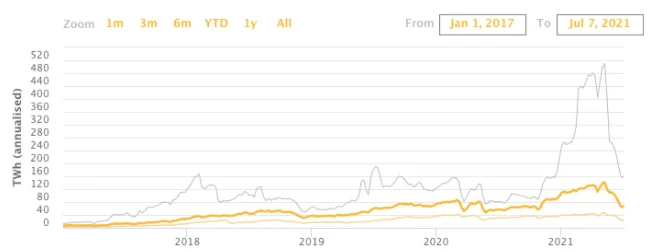Bitcoin’s approximate yearly electricity usage has fallen approximately 60%, from its all-time peak above 143 TWh in May to as low as 62 TWh in early July.

According to data from the Cambridge Bitcoin Electricity Use Index, bitcoin electricity consumption is increasing (CBECI). This is the most economical energy consumption rate that has been tapered since the beginning of November 2020.
Currently, Bitcoin’s annualised electricity consumption is estimated to be approximately 67 TWh, while the upper bound consumption, or the outright optimum overall electricity expense based on the worst case assumption, is 162 TWh, which is significantly lower than the previous peak of 520 TWh in mid-May.
A reduction has also occurred in the lower bound quote, which corresponds to the outright minimum overall electricity expense based on the very best case presumption that all miners always use the most energy-efficient devices available on the market. The lower bound quote has actually decreased from 47 TWh to 24 TWh.

In spite of the fact that worldwide regulators have continued to criticise Bitcoin (BTC) for high energy consumption and the resulting ecological calamity, according to some data, Bitcoin’s energy consumption has in fact decreased dramatically in recent months.
As previously noted, Bitcoin’s parabolic bull run that propelled the cryptocurrency’s price beyond $64,000 in April resulted in a large increase in the amount of electricity consumed by Bitcoin miners, igniting heated debates about the cryptocurrency’s potential environmental impact.
After Tesla CEO Elon Musk banned Bitcoin payments for Tesla car purchases on May 12, the cryptocurrency saw a dramatic drop in value.
According to Bitcoin prices, Bitcoin’s estimated electricity consumption has actually been rapidly decreasing since the statement, a trend that has been exacerbated even further by China’s crackdown on the cryptocurrency mining business.
Following the closure of cryptocurrency mining operations in Inner Mongolia in April, Chinese authorities implemented a series of crypto mining prohibitions in significant crypto mining areas, which included hydropower-dependent provinces such as Sichuan and Yunnan, as well as Xinjiang and Qinghai, among other places.
